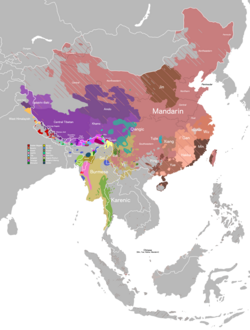Changsha dialect
The Changsha dialect (simplified Chinese: 长沙话; traditional Chinese: 長沙話; pinyin: Chángshāhuà; IPA: [tsã˩˧sɔ˧ɣo˨˩]) is a dialect of New Xiang Chinese. It is spoken predominantly in Changsha, the capital of Hunan province, China. It is not mutually intelligible with Standard Mandarin, the official language of China. ClassificationThe Changsha dialect is what Chinese dialectologists would call a New Xiang variety, as opposed to Old Xiang; the distinction is mainly based on the presence of the Middle Chinese voiced plosives and affricates. The Old Xiang varieties, being more conservative, have in general kept them while the New Xiang ones have altogether lost them and changed them to voiceless unaspirated consonants. Although most Chinese dialectologists treat New Xiang as part of the group, Zhou Zhenhe and You Rujie classify it as Southwestern Mandarin.[1] Geographic distributionThe Changsha dialect is spoken in the city of Changsha and its neighbouring suburbs. However, there are some slight differences between the urban and suburban speech. For instance, the retroflex set is only heard in the suburbs, but not in the city. Further, some words have a different final in the two varieties. DialectsThere are no substantial differences between dialects in the neighbourhoods of Changsha; however, age dialects do exist. For example, the distinction between alveolar and alveolo-palatal consonants is only made by the elderly while the younger generations do not normally distinguish them. The finals [-oŋ] and [-ioŋ] have become [-ən] and [-in] in the younger speech. Also, the initial consonant [ɲ] in the elderly's and middled-aged's speech is either dropped altogether or changed to [l]. Phonetics and phonologyThe Changsha dialect, together with other New Xiang varieties, has lost the Middle Chinese obstruents, which are changed to voiceless unaspirated consonants. It has also lost all the final plosives found in the rù tone in Middle Chinese. Consonants
Vowels
TonesChangsha has 6 tones, which are neutralized in syllables ending in a stop.
See alsoReferences
External links
|
||||||||||||||||||||||||||||||||||||||||||||||||||||||||||||||||||||||||||||||||||||||||||||||||||||||||||||||||||||||||||||||||||||||||||||||||||||||||||||||||||||||||||||||||||||||||||||||||||||||||||||||||||||||||||||||||||||||||||||||||||||||||||||||||
Portal di Ensiklopedia Dunia















